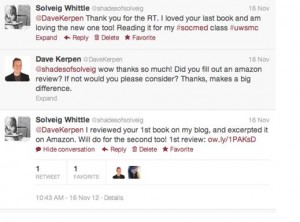 This is a book review of Dave Kerpen’s second book, Likeable Business: Why today’s consumers demand more and how leaders can deliver. Kerpen is the co-founder and CEO of Likable, a social media and word-of-mouth marketing firm in New York. He has also been named the most social CEO of the Inc. 500. I read Dave’s first book, Likable Social Media, and was so enchanted with it that when I heard that he had written a second book, to be released fall of 2012, I ordered it right away. Since the thesis and case studies in Kerpen’s first book seemed directly applicable to businesses of every size and kind, it seemed natural that his consulting experience with companies and social media would easily translate into a more generalized business strategy book.
This is a book review of Dave Kerpen’s second book, Likeable Business: Why today’s consumers demand more and how leaders can deliver. Kerpen is the co-founder and CEO of Likable, a social media and word-of-mouth marketing firm in New York. He has also been named the most social CEO of the Inc. 500. I read Dave’s first book, Likable Social Media, and was so enchanted with it that when I heard that he had written a second book, to be released fall of 2012, I ordered it right away. Since the thesis and case studies in Kerpen’s first book seemed directly applicable to businesses of every size and kind, it seemed natural that his consulting experience with companies and social media would easily translate into a more generalized business strategy book.
The gist of Likable Business is that the same key principles of effective business use of social media – to listen, be responsive, and tell stories – apply beyond social media, to business in general. The book is written for marketers and executives at small, medium and large companies who wish to “reorganize not only the way they do business around their customers, but the way they empower their people to become likable leaders.” (6) As Kerpen states up front, this is not a research-based or analytical book – “for data junkies, something will be missing” (6) – nor is it a list or manual for the latest tools to optimize the online presence of a business. You could, however, call it a manual of business etiquette for modern companies of every size, from one-person consulting shops to large multi-national corporations.
Likable Business is written in the same accessible, conversational and highly readable style as Kerpen’s first book. It is composed primarily of anecdotes and case studies from his personal life, his firm’s customer interactions, and some fairly well-known corporate screw-ups (eg. Comcast) and rock stars (eg. TOM’s Shoes). As the title promises, however, Likable Business enumerates and illustrates, via example and counter-example, the core corporate communications traits and behaviors that drive a likable (and therefore, presumably, successful) business. Many of the case studies still involve social media interactions, although there are some classic communications techniques, such as hand-written thank-you notes and techniques for appreciating and valuing employees (Really?) A few companies are mentioned that are not social-media-savvy (Trader Joe’s) but still manage to earn Kerpen’s “likable” moniker because of the way they treat employees and customers.
Kerpen begins by discussing why it is not only company–to-customer communications that matter, but company-to-employee likability. I think this is an important dimension, because how a company communicates with and treats its employees has a direct impact on how those employees treat customers. We live in a world where dissatisfied employees or dissatisfied customers can quickly destroy a company’s reputation through the power of social media. Likewise, every employee today is a walking advertisement for a company. As Rod Brooks, VP of Marketing at Northwest regional insurance company PEMCO, spokesperson for ShowBox (and former president of the Word of Mouth Marketing Association, WOMMA) says, he wants every neighbor and family member of his employees to be convinced that PEMCO is the best insurance company out there, because “advertising is the price you pay for having an unremarkable product or service.” Word of mouth marketing, an ancient marketing method that seems newly resuscitated by the 21st century advent of social media, necessitates that companies truly walk the talk. Those ideas, really, are the heart of this book. In some ways, it is an almost moral argument that to do unto others as you would have them do to you will result in a successful business, almost as if by magic.
The complete set of “likable” business traits and behaviors that Kerpen lists are listening, storytelling, authenticity, transparency, team playing, responsiveness, adaptability, passion, surprise and delight, simplicity and gratitude. He treats each characteristic by giving it a chapter of case studies, examples, and anecdotes. The focus throughout the book is on “likability” achieved through a return to the, perhaps old-fashioned, idea that marketing and selling are fundamentally social activities. A likable business leader, and thus his employees and company by following, initiates transactions that build trust and create positive relationships. This is not really rocket science, but apparently businesses and leaders need reminding after having spent the 90’s and 00’s feeding their slavish worship of capitalism, the free market, greed, and financial gain – often at the expense of both employees and customers.
“[Listening] requires being extremely present to people as individuals and to the environment that they have created around themselves” (19) “…listen like children watch TV.” (21)
According to Kerpen, being the leader of a likable company, starts with listening to employees as well as customers. Kerpen offers several examples and counter-examples of good corporate listening, including Netflix, Build-A-Bear, Blockbuster, and Dell.
“Storytelling is a primal form of communication, connecting humans universally.” (31)
Great storytelling has always been at the heart of great corporate marketing, from Coca-Cola to Apple. Here, as well as in most of the other chapters, the overlap between Kerpen’s first and second books become pronounced. Storytelling, we have been told again and again, is at the heart of great social media interactions, because social media is really nothing different than well-executed corporate communication. A good product story is what grabs us and makes us pay attention (and ultimately, pay money).
“Authentic business leaders are viewed as simply human.” (53)… “Who you are online is who you are in real life and vice versa.” (57) …“Being authentic requires you to be your true self; transparency helps to convey your authenticity.” (74)
Authenticity and transparency are just as important in likable business leaders as they are in a likable business. I tend to group these two traits together, although Kerpen delineates them in separate chapters. I find the subject of transparency in business, and how I believe it is effecting a positive change on the American business and corporate culture, a fascinating subject. The “humanization” and “vulnerability” of corporations and brands through social media is a deeply attractive trait that creates customer loyalty and generates sales. This is not new – consumers have always wanted to anthropomorphize brands – to identity with the positive attributes of a brand and to reject those brands with negative behaviors and attributes, such as unsustainable production or unfair labor practices. Today, however, the cultish nature of mass-market corporate branding is emerging in examples such as Best Buy, Old Navy or Jet Blue.
The line blurs even more for personally branded figures like Bethenny Frankel or Aliza Licht of Donna Karan, who Kerpin remind us are corporate social media personalities with loyal followings similar to Justin Bieber and Lady Gaga. This is almost a fetishistic cross-breeding of personal and corporate branding. Many highly successful corporations are more than brands, they are institutions whose positive values and beliefs can be transformative for their audiences, hopefully for the good, which brings us to the next section of the book.
“When praised, a great leader credits his or success to others and maybe a little luck” (87).
The next sections of the book cover team playing, responsiveness, and adaptability. “Pivoting” and being “agile” or “nimble” are some of the corporate strategy buzzwords used today, and Kerpen uses them to make sure we make the connection to other contemporary business strategy books. He gives examples of both companies and leaders who exhibit these traits, from a local Boston sandwich shop, Boloco, to social media behemoths Facebook and Google. He also covers companies that failed to embrace these traits, such as Circuit City and Borders. (I liked that Kerpen covers both examples and counter-examples of each trait throughout the book.)
Finally, passion, the desire to surprise and delight, simplicity, and gratefulness, all round the book out as traits that serve to initiate and cement a customer relationship by creating a truly a satisfied customer, one that can be turned from a critic to a brand evangelist.
“Every mistake is an opportunity to surprise and delight” (165)
Kerpen relates a personal story of his own, at first negative, and then positive, experience with Loews Royal Pacific Resort in Orlando, FL. Great customer service can turn a bad day into a surprisingly delightful one, and can create a loyal customer from a critic. By admitting mistakes, apologizing, and rectifying the situation, companies are not only restoring trust in their brands, but also creating trust in others, as these actions are now public and highly visible through social media. The final chapter on gratefulness (really giving back and corporate altruism) and it’s marketing-speak term, “cause marketing”, could be the subject of a whole other book. It rounds out the moral high tone of the book, which essentially exhorts leaders to be better people.
I was struck by the book’s repeated emphasis on the power of empathy with the customer and with the employee as a corporate value. There is a magic that happens when one party in any kind of relationship says “I’m sorry”, and it is universal and powerful. Ultimately, what Kerpen is talking about is a responsive company that is in a genuine dialog, in a genuine relationship, with its customers. Social media is a conversation, and being a likable business is about engagement and long term relationships based on shared values. Marketing and corporate communications are no longer about trying to figure out how to enumerate product features, determine customer benefits, and list talking points. 21st century business is about listening to what customers want to buy, and creating a relationship so you are the first brand they consider when they are ready to purchase.
Kerpen ends the book with a great analogy: business, and indeed social media, is like a cocktail party. Be flexible, responsive, authentic, passionate, grateful, and have a few tricks up your sleeve, and you will be successful in business, he says (201). I could argue these are generally good traits for anyone to have and are thus words to live by in any profession.

I have my own story to tell about Kerpen’s likable business practices. As I was reading this book, I tweeted a picture of the Likable Business pyramid (above), and attributed it to @davekerpen. I was surprised and pleased that, within a few minutes, Kerpen had retweeted my post to his 50,000+ followers.
 Note that I received a second retweet by Kerpen (of my book review) to his many followers. I was liking Dave Kerpen very much at this point, as he gained me a few more followers of my own on Twitter that day. A few days later, as I was writing the first draft of this paper, I tweeted Kerpen again, asking permission to use the pyramid graphic in my book review, and asking if there was a .jpg version I could get from him that would be better than the digital picture I had taken originally.
Note that I received a second retweet by Kerpen (of my book review) to his many followers. I was liking Dave Kerpen very much at this point, as he gained me a few more followers of my own on Twitter that day. A few days later, as I was writing the first draft of this paper, I tweeted Kerpen again, asking permission to use the pyramid graphic in my book review, and asking if there was a .jpg version I could get from him that would be better than the digital picture I had taken originally.
A woman on Kerpen’s staff named Theresa Braun replied to me within ten minutes, got my email address, and sent me the graphic immediately. I was impressed enough to tweet out what a great experience it had been working with Kerpen and his staff (which, of course, Kerpen also retweeted, my third RT from him in a week!) This very likable customer and employee interaction rewarded not only me, but Kerpen’s very responsive and likable employee, Theresa. Clearly he walks the talk – a likable business for sure.
Kerpen’s book is very accessible, and an easily digestible reminder of the basic principles of good business and good marketing communciations. It’s a great general strategic business and leadership book for the 21st century. The only constructive criticism I have for the book is to include a few more truly difficult situations where companies have responded to challenging public relations situations not just by reacting in a transparent and apologetic way, but by using the customer goodwill they have accumulated through their prior investment in likable actions. The key benefit of becoming a likable business comes, I believe, when customers have the choice to either become advocates for a company or throw it under the bus. Finally, I will caution readers that if they have read, as I did, Kerpen’s first book, Likable Social Media, the second book may seem somewhat repetitive. It is not a strategic analysis or management book, it is more a manual for good business behaviors, particularly at the executive level.




1 comment